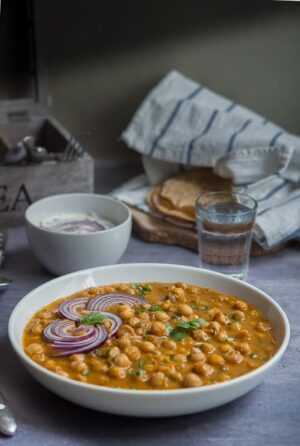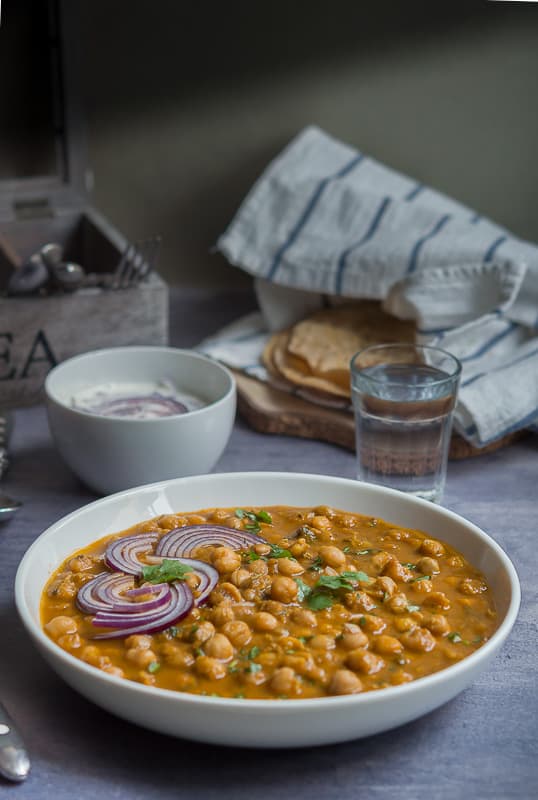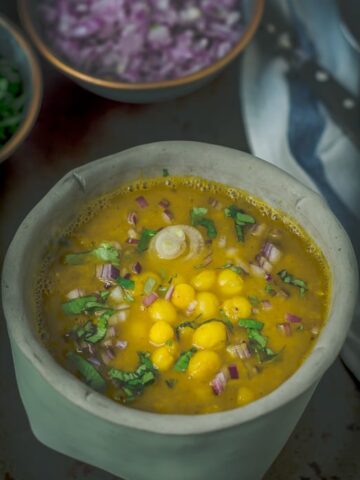Channa masala or chole masala - chickpeas cooked in a tangy onion-tomato sauce with a special blend of spice mix. This is my family recipe and it has some interesting twist to the recipe. You can pair this with rice or roti or any kind of flatbread.
Recipes are more adaptable and versatile. It gets changed due to one's own taste, preference and their lifestyle choices. So is the case with this delectable and savoury Chole Masala. Myriad recipes are out there on the web. Even though the base ingredients remain the same, every family has its own way of cooking this. The recipe may be passed down the generations, by word of mouth or many pick it up from the all in all Guru - the Google. Nowadays, the internet has become an extensive reference for all recipes. After trying out so many recipes and experiments, I settled down with this variation one that is very similar to my mom-in-law's preparation. This is my tried and tested recipe that has got me so many adulations and has never failed me once. This has become my signature dish. Cock-a-doodle-doo!

Making a mouth watering channa masala or any Indian curry for that matter depends on how perfectly you cook the onion tomato paste. It may sound daunting but practicing it for a couple of times makes it easier. Let me share the changes that significantly improved the recipe.
1. Cooking the onion-tomatoes mix.
While making tomato purée, use fresh ones and not canned. This may sound cliché but I still emphasize on this because, (I). Regular use of canned foods are not good for health. (II). Fresh produce is always clean and good and they taste much better. The masala, i.e. the onion-tomato mixture, has to be cooked well until the moisture dries and the raw smell goes off. To know more, read this post where I have explained in detail on how to cook the onion-tomato masala for Indian dishes.
2. Spice Mix - Channa Masala powder
Next is the dry spice mix that is used. Some people use the common Punjabi dishes' spice mix - cumin, coriander and garam masala powder. There is nothing harm in using this but then all your north Indian dishes would taste the same. There is a difference in the flavour and aroma of every dish and brings out the exact flavour of the dish. The channa masala powder has some spice powders like amchur (dry raw mango powder), dried pomegranate seeds, all of which gives a unique taste to the final dish.
You can use home made Channa masala spice mix or a store bought one. I usually use the Everest brand.
3. Sourness
Sourness in an Indian curry is as important as the spices that go in. Up until the introduction of tomatoes in the 17th century, we used curd (yogurt), lime, tamarind, kokum, amchur, etc... to get the sourness. If you feel your dish is too spicy or missing the zing (as the tartness in tomatoes vary with season) in this recipe, use lime juice and extra yoghurt to compensate. You can also increase the amount of tomatoes. Try the onion:tomato in 1:2 ratio and increase up to 1:3 if necessary.
Channa masala is slightly tangy when compared to rajma masala or dal makhani or other north indian dishes.
4. Variation to the regular Punjabi channa masala
-
- The addition of capsicum seeds. I use this to spice up my dish and it is purely optional. This is a great way to use the seeds instead of discarding them. Just use one or two (if the peppers are ver small) so that it doesn't overpower. If you add them, slightly adjust the amount of green chilli and chilli powder. The spice level of the seeds vary from pepper to pepper.
- We use a generous amount of fresh cilantro / coriander leaves while grinding the wet masala. Addition of cilantro is purely optional and this is our family version. The fresh coriander leaves gives a refreshing and aromatic flavour to this dish.
The above two variations give a refreshing taste to the regular channa masala. This has become a keeper recipe and nowadays I make sure I have capsicum with me while making this.

- 1 cup chickpeas, soaked overnight
- 1 black cardamom, 2 cloves, 1 bayleaf and a tea bag
- 1 tablespoon oil
- 1 tablespoon butter Vegans can use coconut oil instead of butter
- 1 bay leaf
- ½ inch cinnamon
- ½ teaspoon cumin seeds
- ¼ teaspoon turmeric powder
- ¼ teaspoon cumin powder
- ½ teaspoon coriander powder
- 1.5 teaspoon channa masala powder
- 1 teaspoon red chilli powder (adjust the spice level as needed) refer notes 1
- 2 tablespoon yogurt | curd
- Salt to taste
- Coriander leaves for garnishing
- ½ tablespoon kasuri methi ( dry fenugreek leaves)
- 2 teaspoons lime juice optional
- 2 medium sized tomatoes, roughly chopped
- 1 medium sized onion, cubed
- ½ inch ginger
- 2 cloves garlic
- 2 green chillies
- 2 tablespoon chopped coriander leaves optional ( refer notes 2 )
- 1 seeds (& pith) from 1 capsicum( bell pepper, any kind ) optional ( refer notes 1 )
-
Pressure cook the chickpea with salt, black cardamom, cloves, bay leaves and tea bag, until it is tender, for 10 minutes on medium high flame ( about 5-6 whistles). Drain the excess water and reserve it. (refer notes 3)
-
In the meantime, grind all the ingredients mentioned under wet masala to a smooth paste.
-
Melt butter and oil in a heavy bottomed pan / kadai (use cast iron or carbon steel pan) on medium high heat and once it becomes hot, add the bay leaf, cinnamon, black cardamom and cloves. Be careful as the spices might pop in hot oil. Use a splatter grill. Once they sizzle and becomes plump, remove them from oil.
In the same pan add the cumin seeds and the ground wet masala ( onion-tomato paste ) and keep frying them.
-
Cover and cook for about 12-15 minutes. Again, be careful as the tomato mixture will bubble vigorously. Stir in between to prevent it from burning at the bottom of the pan.
-
Then remove the lid, add turmeric, channa masala powder, chilli powder, cumin powder and coriander powder. Mix well. Add yogurt, mix well.
Keep sautéing until the the mixture thickens and comes clean off the pan. (refer notes 4)
-
Now add cooked chickpeas without the water. Mix it well. Then add about 2 cups liquid ( either water or cooked chickpea liquid) and mix it well. Check for seasoning and add more spice mix if needed.
Cover and simmer it for 10 minutes.
-
Just before turning off the flame, add kasuri methi leaves by crushing the leaves between your palm. Then turn off. Garnish it with coriander leaves. If you need more tanginess, add some lime juice.
The gravy thickens on cooling. If you feel the consistency is thick add some more water and dilute it a little before serving. Sometimes when you reheat it will liquify. Adjust accordingly.
- The addition of capsicum seeds is purely optional. I use this to spice up my dish. This is a great way to use the seeds instead of discarding them. If you add them, adjust the amount of green chilli and chilli powder.
- The addition of coriander leaves while grinding the paste is optional. Fresh coriander leaves give a very nice flavour.
- It is okay if the chickpeas gets a tad overcooked but it should not be smashed completely. You can also add baking soda to soften the chickpeas quickly.
- This does not mean you will find a pool of oil, just the amount of oil you used in the beginning will start to go to the sides. Also if you use a non stick pan and reduce the amount of butter / oil in cooking, you will not be able to see the oil separate. So just cook until the mixture comes clean off the pan while mixing it. Refer to this post for further details. The water content from the masala must go off.
- When you add the chickpea cooked water, be careful while adding salt. The chickpea water will have salt and it might easily become too salty if you are not careful.







Beena says
OMG I love your presentation..its the best!!! , so many tips and clarity in explanation . Lovely .. I tried your Dal Makhani , it was awesome. Now I am going to try more dishes from your blogs. Thank you Nisha, you make a big difference by sharing your culinary skills.
Nisha says
Thank you Beena. You made my day 🙂 I am glad to help you out in a small way. Cheers cooking!
Grytsje says
Tomorrow, I'm planning to make this recipe, but I am a bit confused by step 2 in the recipe. Is the mentioned 'wet masala' the same as the onion tomatoe base? If not, when does the 'wet masala' come into action in the recipe? If it is, do the garlic, ginger and chillies replace the coriander powder, the red chilli powder and the cumin powder from the base recipe? Some help would be greatly appreciated, thanks!
Nisha says
Hi Grytsje, So sorry missed your comment as I was on vacation. The onion tomato paste mentioned in step 3 is the wet masala that we have ground in step 2. It includes onion, tomato, ginger, garlic and chillies, everything mentioned in the wet masala ingredients. I have corrected step 3 to be more clear. Then after this masala is cooked, we add the dry spices as well. Garlic, ginger and chillies do not replace the coriander powder, the red chilli powder and the cumin powder from the base recipe. Hope this helps. PLease let me know if you have more questions. I am happy to help!
Ramya Krishnamurthy says
yummy and mouthwatering chole
Nisha says
Thanks ramya!